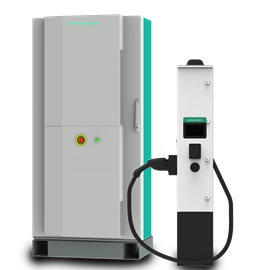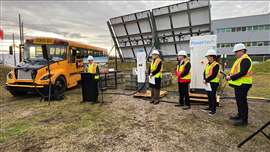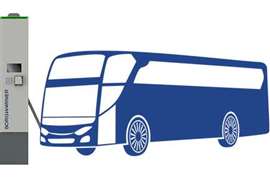Bidirectional EV charging can provide fleet benefits while supporting the grid
11 April 2024
Demand for electricity does not remain constant. Instead, spikes often occur. These can be the result of widespread behaviors across a large population, such as when large populations of people are at home and using power at a given time, or they can be attributed to weather phenomena such as high temperatures. Last October, for instance, the U.S. Energy Information Administration (EIA) reported that peak electricity demand on July 27, 2023, at nearly 742,000 megawatthours (MWh), almost broke a record set in July 2022.
One approach utilities use to manage surges in demand is called demand response. This is the set of opportunities a utility presents to electricity users to reduce or shift their energy usage during times of high demand in exchange for preferential rates or other incentives, according to the U.S. Dept. of Energy.
Soon, however, utilities may have another tool to address peaks in demand: bidirectional electric vehicle (EV) charging, also called vehicle-to-grid (V2G) technology. Such a practice would allow them to tap into the unused power stored in battery electric vehicles (BEV) when they are charging over long periods.
Bidirectional Charging 101
Mobility solutions provider BorgWarner offers two bidirectional chargers, which it manufactures at its facility in Dearborn, Mich. One is a 60 kW DC fast charger, and the other is 125 kW.
“The 125 and the 60 both work in the commercial market, depending on whether it’s a Class 8 truck down to a regular vehicle,” said Dick Johnson, director of sales, EV charging North America for BorgWarner.
 A BorgWarner bidirectional EV charger. (Photo: BorgWarner)
A BorgWarner bidirectional EV charger. (Photo: BorgWarner)
According to Johnson, not every EV charger is designed for bidirectional charging.
“In order to do vehicle-to-grid, you do have to have a flow both ways in the charger,” he said. “Most chargers don’t, although there’s a lot of competitors out there that say they have it. But they don’t really have it, because they don’t have the UL, SA and SB qualifications to do it, which the utility requires.”
He added that the vehicle itself must also be capable of bidirectional charging. This means it must be able to send power back through the charger, not simply accept it. Finally, the utility must be willing to interconnect with a bidirectional charging system. According to Johnson, making this connection and conforming to the utility’s installation specifications can take six to eight months.
The actual bidirectional charging function is managed by aggregation software.
“With V2G aggregation software, it basically communicates through the charger to the vehicle — basically communicating to the battery and then back up to the cloud,” he said, adding that upon connection with the utility, it will be able to access the batteries at certain times. “In a lot of cases, what they [the utilities] are doing right now is they don’t have an app that does that. They basically say, like a day ahead of time, we need your vehicles plugged in between 4:00 in the afternoon and 7:00 at night.”
Such schedules are important for the utility to be able to access EV power to manage demand.
Ideal Duty Cycles
According to Johnson, bidirectional charging is not necessarily ideal for every BEV fleet.
“If you’ve got cross-country trucks, it probably doesn’t make sense unless there are charging hubs along the way,” Johnson said, “and they’re parked at night or they’re parked at different times.”
The overnight parking Johnson mentioned is key to making bidirectional charging work from a demand response perspective, because late afternoons and early evenings are when many utilities experience spikes in demand.
 In December 2023, Fermata Energy announced it was part of Canada’s first bidirectional electric vehicle (EV) charging hub project in British Columbia. (Photo: Mark Rabin, Coast to Coast Experiences (CTCE))
In December 2023, Fermata Energy announced it was part of Canada’s first bidirectional electric vehicle (EV) charging hub project in British Columbia. (Photo: Mark Rabin, Coast to Coast Experiences (CTCE))
Johnson said that among the fleet types that BorgWarner views as ideal for bidirectional charging, “the big one we’re focused on right now is refuse trucks, because they go out in the morning, come back in the late afternoon — the perfect time to actually use them — have huge batteries and are all close together [when charging].”
Another good fleet application is school buses.
“I think the school bus market is the poster child for a reason,” said George Miller, director of business development for EV charging technology company Fermata Energy. “It makes a lot of sense to utilize these vehicles, because they’re generally operating twice a day and not much in the summertime. So, they are oftentimes done with their routing around 4:30 or 5:00 in the afternoon. That’s when most people are getting home, and they’re turning on their dryers and air conditioning and all of these power consumption pieces.”
Earning Additional Revenue
Johnson noted several reasons why V2G is important for fleets, including the added value they can get from their vehicles as well as increased ROI, both of which come from the additional revenue generated via utility incentives. One case study Johnson shared concerned Highland Electric Fleets, which electrifies school buses.
“Basically between 2021 and 2022 — and they’re still doing this — they [Highland’s customer] earned about $23,000 for plugging two buses in during the summer peak time,” Johnson said. “So that just gives you a touch point as to what the potential revenue is there.”
Utilities Must Plan
While utilities in many states are open to using bidirectional vehicle charging to manage peak demand, many are still researching the application. One challenge is ensuring the existing grid infrastructure can handle V2G. Zachary Kuznar, managing director of grid solution development for Duke Energy, said that if several large fleets, such as those used for last-mile delivery, adopted V2G simultaneously, it could significantly overburden the grid.
“The transformers and the distribution and transmission infrastructure is not designed right now for all of those facilities to put in 100 delivery vehicles and then just have the electric system be ready to handle that,” he said. “That’s a lot of load.”
According to Kuznar, before implementing V2G, it’s important for a utility to understand the capacity of the system and the ability to manage charging so that all vehicles aren’t charging at once. This will ensure that no significant grid upgrades are required to handle the electric load.
Nonetheless, V2G appears to be a step in the right direction as an option for managing surges in power demand.
“EVs can really be an asset to the grid and grid resiliency,” said Jeff Monford, a spokesperson for Southern California Edison (SCE). “We welcome and encourage vehicle-to-grid integration and its future capabilities. There will be an everyday use for bi-directional vehicles and equipment that, if leveraged well, can benefit customers and the grid. SCE is at the forefront of enabling it, helping it become available at scale and set industry standards.”
STAY CONNECTED



Receive the information you need when you need it through our world-leading magazines, newsletters and daily briefings.
CONNECT WITH THE TEAM







